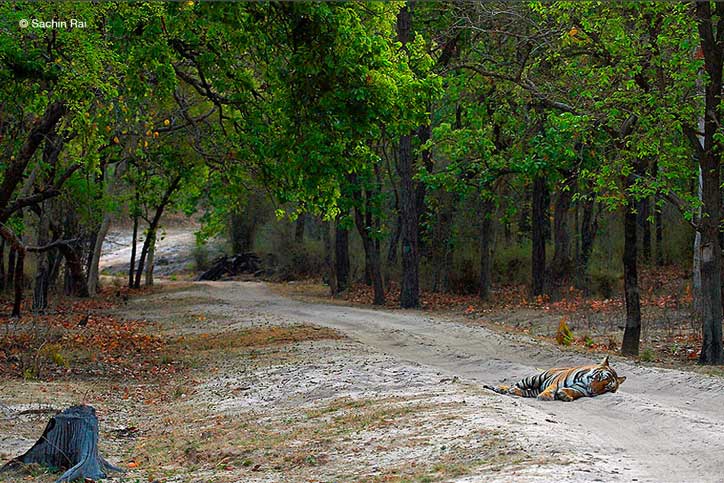 Bandhavgarh:
Bandhavgarh: Carnivores and other creatures of the Bandhavgarh forests are perking up to the rutting sounds of Chital, the spotted deer -- for the first time in seven years.
The sounds in the core areas of Bandhavgarh are a happy augury, say forest officials. It shows Chital stags are fighting with one another for mating rights and herding together estrus females in their period of fertility, which are apparently now in abundance.
The herds are said to have moved back to the core areas from the periphery near human settlements -- over 120 villages in the buffer zone -- where they had strayed in search of food and water, drawing the felines, or the big cats, of the Bandhavgarh Tiger Reserve.
Because of this not only had the tiger sightings near the villages increased, the cases of man-animal conflict also snowballed in the past few years.
"Chital are favourite food for tigers. Bandhavgarh has mostly Chitals, apart from a few Gaurs (Indian Bison) and Sambars (larger species of deer)," the reserve's Field Director Mridul Pathak said.
"Rutting calls in the core area had dropped in the past six to seven years, but they are now significantly improving," says Satyendra Tiwari, a former government official, tour operator and advisor to the National Tiger Conservation Authority (NTCA), a statutory body.
According to official records, the presence of Chitals around human settlements had attracted a large number of tigers, with some villages being marked as "Tiger villages".
"Gohadi village was among the most affected by the tiger menace. People noticed the presence of tigers on at least 11 different occasions," said a forester.
Other villages that suffered from the tiger menace are Godhpuri, Hardia, Damma and Ghadhua, with sightings of four to seven tigers in each of them. At present, Bandhavgarh has one of the highest tiger densities in India with about 55 adult tigers, around 25 cubs aged between six months and two years, and approximately 20 below six months' age.
For conservationists, the challenge was to bring the deer back to the grasslands, thereby drawing the tigers away from human habitats.
The task was not easy. The process involved working in a core area spread over 920 sq km. The grasslands had to be revived with soft grasses, the water channels fixed and micro-nutrients added to water bodies.
Coarse grass dominates the Bandhavgarh expanse and grows wild as Sambars and Gaurs -- whose primary food it is -- are low in numbers. The entire population of Gaurs is about 130, with 49 of them relocated from Kanha National Park in 2010.
A VIP-visit also helped. So excited was the visitor on animal sightings that he helped arrange for a Swiss grass-cutting machine that was sought by the officials. The machine chops the upper part of coarse grasses and grinds the residue for compost, which helps with the growth of the soft grass below.
Teams then turned to water holes. "We checked the mineral levels in the water holes. If the micro-nutrients are low, animals tend to change the water sources," the forester said. Salt was used to clean and increase nutrients in the water and potassium permanganate added for healthy skins of animals.
"We began with the Tala zone, the biggest and richest of all, in November 2016," Pathak said, adding that check-dams were created and dried water channels revived.
"Things worked out as planned. Soft grass grew, water channels were revived with the water level rising and holes were medicated. Only the inhabitants were missing," Pathak recalled.
And here Lord Rama was invoked. The temple fort on a prominent hillock gives the park its name Bandhavgarh -- or Brother (Laxman's) Fort. Officials led by Pathak visited each village around the zone, met the village head and elders and pointed out the growing menace of man-animal conflict and sold them on the idea of holding "Ramayana-Path for good luck".
The villagers, mostly the Baiga and Gond tribals and some Yadavs and Brahmins, were provided loudspeakers to recite Ramayana and given crackers to frighten the animals away.
"Within a few days, Ramayana started showing its miracle. The heavy sounds from loudspeakers and crackers spooked and pushed the Chital back to the forest. Once the herds started moving back, they stayed in core area," said Field Director Pathak with a chuckle.
"Notice that their numbers are impressive, they all have a healthy glistening coat and each herd, small or big, has fawns," Pathak said with a spread of his hands as hundreds of Chital grazed and gambolled about gracefully in every nook of the Tala zone. And where the prey goes, so do the predators. The tigers have moved away from the villages.
"You will further see the difference during your next visit," Pathak says as a bellow echoes across the woods, "You hear that? That was rutting.". As another night passes in the jungle, he has reason to thump his chest in pride.
 Bandhavgarh: Carnivores and other creatures of the Bandhavgarh forests are perking up to the rutting sounds of Chital, the spotted deer -- for the first time in seven years.
Bandhavgarh: Carnivores and other creatures of the Bandhavgarh forests are perking up to the rutting sounds of Chital, the spotted deer -- for the first time in seven years.